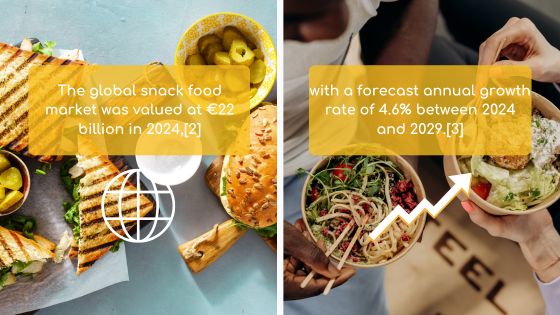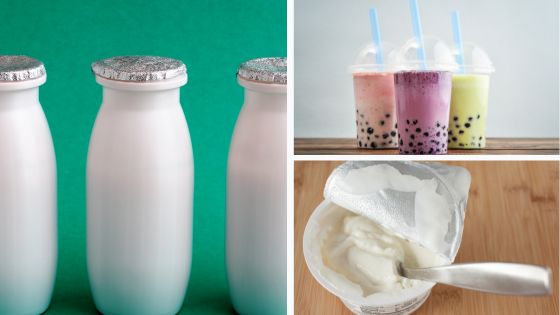
Snacking and meal splitting: optimizing taste and nutrition with dairy ingredients.
The traditional model of three meals a day is gradually giving way to a more flexible and on-the-go eating pattern. Snacking and meal splitting offer tasty and functional alternatives to conventional eating habits. According to the American Heart Association, a snack is a food intake perceived as separate from main meals, consumed outside of established mealtimes, and accounting for less than 15% of daily energy intake.[1]
The rise of modern snacking is part of the growing meal splitting trend
A fast-growing global market
The global snack food market was valued at €22 billion in 2024,[2] with a forecast annual growth rate of 4.6% between 2024 and 2029.[3] This trend is already well established: 17% of American adults now replace their routine meals with snacks.[2]
Meal splitting: a consequence of modern lifestyles
Faster lifestyles, flexible working schedules and the increasing prevalence of remote work create a favorable environment for meal splitting and snacking at home, a phenomenon that is less common in the workplace.[4][5] According to Mondelez International’s 2024 Global State of Snacking Report, 62% of respondents prefer eating several small meals throughout the day rather than a few larger ones.[6] This trend toward meal splitting is reflected in the establishment of regular breaks throughout the day, which are ideal moments for snack consumption: 67% of working people report taking a morning break, and 55% take time out in the afternoon.[7]

The functional snacking trend: more than just a quick bite
For some, snacking is a practical response to a busy schedule, for others, it’s a strategy to optimize nutritional intake. Functional snacking forms part of the growing trend of “better-for-you” products: enriched with proteins, fiber and vitamins, and reduced in sugar or salt, without compromising on taste pleasure.[8] Consumers prefer naturally functional ingredients, recognized for their intrinsic nutritional benefits (fiber, protein, and antioxidants). They are more reticent with regard to complex food innovations, which are sometimes considered too technical or difficult to understand.[9] Personalization is also key: whether it’s for sports nutrition, weight management, or targeted wellness, each snack is expected to meet a specific need.[7][10]
The challenge of mobility: designing products for new consumption habits
Snacking: an on-the-go consumption model
Out-of-home eating opportunities are on the increase e.g., on public transport, at the office, or after a workout. Snacking has become an efficient way to stay nourished without disrupting one’s daily routine. Morning and afternoon snacks, pre/post-workout bites, and quick lunches on the go are the most common expressions of this trend.

Formats and key criteria for a successful on-the-go product
A relevant on-the-go product is based on four essential elements: portability, with a compact, lightweight and resistant format; ease of consumption, enabling quick consumption without utensils or preparation; intelligent packaging, i.e., single-dose, easy-to-open packaging, limiting waste; and finally, good stability, which facilitates storage at room temperature without compromising on quality. The most popular formats are ready-to-drink (RTD) beverages, protein and energy bars, gourds (compotes, yoghurt drinks) and individual portions of everyday foods (cheese, cookies and crackers).
Optimizing snack formulation with the properties of dairy proteins
The inherent benefits of dairy ingredients
Dairy proteins have a dual benefit: nutritional (rich in complete proteins and calcium) and functional (texturizing and stabilizing properties). Their neutral taste and compatibility with a variety of formulations make them ideal for on-the-go snacking products.

Pronativ® Native Whey Proteins: the formulation partner for high-protein and sensorially balanced products.
Pronativ® Native Whey Proteins offer a triple advantage in formulation. Nutritionally, they have a high leucine content, an amino acid essential for muscle protein synthesis, beneficial both for sports nutrition and to maintain muscle mass in older adults. From a sensory point of view, they are distinguished by a neutral aromatic profile, guaranteeing the taste integrity of recipes without the development of undesirable off-notes. Finally, from a functional standpoint, they ensure regular and stable textures over time, while being easily integrated into various formats such as bars or drinks. In view of these objectives, caseins, whether obtained with rennet or by acidification, also represent particularly effective protein sources: their ability to form cohesive and stable structures makes them the go-to ingredients for improving the texture, firmness and stability of protein bars.
Pronativ® Native Micellar Caseins: the key to high-nutrient snacks.
Thanks to their unique technological profile, Pronativ® Native Micellar Caseins are particularly tailored for the development of protein snacks such as drinks and oral nutritional supplements. Their neutral taste and low viscosity facilitate the formulation of high-protein products while ensuring a fluid, stable and well-balanced texture, meeting the expectations of consumers looking for both eating pleasure and convenience. As “slow” proteins, they also help to prolong the sensation of satiety, a key asset for functional snacks aimed, among other purposes, at regulating appetite between meals.
Conclusions
Meal splitting and on-the-go consumption are not simply short-term fads, but fundamental trends that are redefining the food industry. Success in this market depends on the ability to offer products that combine convenience, taste pleasure and targeted health benefits. Thanks to their high nutritional quality and unique functional properties, dairy ingredients are essential allies. They facilitate the development of new functional and tasty snacks capable of meeting the expectations of tomorrow’s consumers.
A question ? Contact-us !
Sources:
[1] Marangoni et al., Snacking in nutrition and health, International Journal of Food Sciences and Nutrition, 2019
[2] Paul Fedèle, Snacking, Speak Snacking. Tendances et défis du marché du snacking en 2025, 2025
[3] Euromonitor International, World Market for Snacks 2024 report, 2024
[4] Agro Média, Croissance mondiale pour le snacking, 2021
[5] Sandwich & Snack Show, Communiqué de presse. Le snacking en force !, 2022
[6] Mondelez International’s, State of Snacking study,2024.
[7] Dr. Ravinder Varma, Future of functional snacks: Serving health-focused, mobile consumers, 2024
[8] Food Industry Executive, The Better-for-You Revolution: Redefining Snacking for Health, Energy, and Wellness, 2024
[9] NewNutrition Business, 10 Key Trends in Food, Nutrition and Health 2025, 2024
[10] FranceAgriMer, Pratiques de consommation en alimentation spécialisée – Synthèse, Les études, 2024















